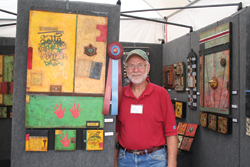



Encaustic
Enthusiast
Papka
earned ‘Best of Show’
in his first Chautauqua appearance
The
central Kentucky artist
says his works are ‘experimental’
By
Helen E. McKinney
Contributing Writer
(September 2012) – After spending 37 years as
a research scientist and professor of anatomy and neuroscience, artist
Raymond Papka has learned to employ many aspects of art to and in his
research and teaching, combining his varied interests. His detailed encaustic
paintings are full of life and depth, drawing the observer into a spectral
world.
Papka, a Versailles, Ky., resident, said encaustic painting “feels
very experimental. Each piece I work on feels so different and has different
requirements. It is very forgiving, and it can be manipulated.”
 |
|
Photo
by Emily Ward Raymond
Papka of Versailles, Ky., |
Encaustic painting is an age-old artistic technique. It
is often referred to as “hot wax painting” because in Greek
the word means “to heat,” “to burn in” or to “fuse.”
Ancient Greek shipbuilders used hot wax to fill the cracks in their ships.
Pigment was later added when the surface of the waxed hull was painted.
The process uses melted beeswax mixed with natural resins and colored
pigments to give a colored or opaque effect. If the artist is going for
a transparent effect, the pigment may be omitted.
“You actually paint slowly then reheat the “painted wax”
to smooth it, fuse it, move it and manipulated it,” said Papka, 67.
“The beeswax of encaustic painting allows me to generate layers of
information in my artwork, but keep it mysterious – almost dreamy
and historical.”
After encountering an encaustic painter at an art fair, Papka said he,
“loved the look of her work, took a workshop from her and was sucked
into this medium.” Papka’s take on encaustic painting is a mixed
media combining “assemblage, encaustic painting, the use of books
and wood panels as substrates, and found objects as relevant embellishments.”
He quickly paints the melted beeswax onto a rigid surface, such as a wood
panel. After each layer of encaustic paint is reheated to fuse it with
the previous layer, it cools, then the wax-resin cures to create a stable
archival painting that can last for centuries, said Papka, who is originally
from Thermopolis, Wyo.
Papka, a self-taught artist, was the 2011 Best of Show winner in the 2011
Madison Chautauqua. Papka felt he won because “the judges thought
my artwork was just so different and unique, and it has a combination
of storytelling, assemblage and construction as well as painting.”
Last year was the first time he had participated in the Madison Chautauqua.
Papka usually takes part in 10 to 12 fine art shows across the country
each year.
“The encaustic medium lends itself well to abstract art as well as
contemporary paintings,” he said.
Papka often uses photo transfers of images he has taken in his travels
– images he designs on Adobe Photoshop and images derived from
old games and “other materials I find in flea markets, antique stores
and simply along the way.” He then scans them into photo imaging
software for incorporation into his assemblages.
Papka’s creations “are not craft work, it is artwork,”
said customer Robert Whelchel of Angola, Ind. His art “has enough
ambiguity to it to for someone to sit and stare at it and get different
ideas.”
Whelchel has purchased two pieces from Papka. Both pieces involved the
theme or concept of time. The first piece, titled “Time and Distance,”
incorporated a swinging pendulum. The second piece included a rotating
cylinder that when pulled across the picture would move a historical timeline.
Each portrays “a different sense of time,” said Whelchel.
He said he had “never seen anything done like this before in wax.”
Whelchel first encountered Papka and his unique artwork at Francisco’s
Farm Art Festival in Midway, Ky.
Papka’s artwork appeals to Whelchel because he also has a background
in engineering. “His work is really interesting to me.”
Many times Papka will create an altered book, a form of artwork that changes
a book from its original form into something else. “I take a book
(old, new, recycled or multiple) and cut, tear, glue, burn, fold, paint,
add to, collage, rebind, gold-leaf, create dimension, drill or bolt it.
Sometimes, I add pockets and niches to hold tags, secret drawers and ephemera
or other three-dimensional objects,” Papka said.
The use of books permits him to work in a three-dimensional context that
other artists must create in their craft, he said. Working with this medium
“allows me the excitement of discovering interesting oddities of
information in the books that I am manipulating.”
Papka said his work is continually evolving and is inspired by issues
in biology, the influence of science in his life, and the major players
in the history of science and religion. “I utilize the interrelations
between math, science, music, philosophy and practical applications in
technology. My love for books influenced my decision to recycle them in
an altered form and continually utilize themes involving text.”
Papka has also been a life-long hobbyist of woodworking, furniture design
and finishing. Many jobs he completed as a youth often involved carpentry
and metal work, fueling his artistic skills.
Madison Chautauqua Archived Articles |
|||||
| 2014 | 2013 | ||||
| 2007 | |||||